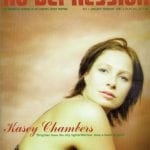American Roots Music
At the end of the second segment of the four-part American Roots Music special, narrator Kris Kristofferson states with wonder that from 1930-1954, America gave birth to country and western, western swing, honky tonk, bluegrass, and rock ‘n’ roll, and also became broadly aware of traditional folk music. It’s a simple statement, but breathtaking — even as it comes after only an hour spent documenting this fecund period.
A skeletal look at the PBS special suggests a Monty Python-speed Shakespeare skit: an hour for both pre-commercial folk and early hillbilly and race music (and Thomas Dorsey!); an hour for the emergence of modern country and blues (and Elvis!); an hour for modern gospel and the folk revival (and B.B. King!); and an hour for Cajun, zydeco, Tejano, and Native American music (and Ralph Stanley!).
The easy response is: It’s better than nothing. And yet, given the involvement of, as producer Jim Brown puts it, a “dream team” of institutions and resources (including the Library of Congress, the Smithsonian, the Rock and Roll Hall of Fame, the Country Music Foundation, and the Experience Music Project), it’s hard to imagine how or why Palm Pictures and the Ginger Group (the main brains behind the special) could not muster the resources necessary to, at least, double the program’s length, if not achieve a Ken Burnsian grace and depth.
Better than nothing, perhaps. But this short series now makes the likelihood of a richer narrative of our musical heritage being offered to the public all but moot. The great Lydia Mendoza gets her five seconds in the mainstream spotlight, and it’s not likely she’ll get more soon.
American Roots Music, however, offers considerable pleasures and some genuinely stunning scenes: Bascom Lamar Lunsford playing the banjo, Bessie Smith moaning the blues over a beer, Son House rocking “Death Letter”, FDR surrounded by a string band and looking very uncomfortable, Uncle Dave Macon twirling his banjo like a baton, Woody Guthrie singing with Sonny Terry and Brownie McGhee, Merle Travis covered in soot to sing “Dark As A Dungeon”, James Cotton blowing his harp hard for hell, the Clara Ward Singers in full beehive hairdos, and cajun greats the Balfa Brothers playing at home. All are, predictably, cut short. The viewer aches for more.
More problematic is the overall tone of the commentary. Ranging from the weird hyperbole of Marty Stuart (“Uncle Dave Macon was the first rock star”) to the jejune Keb’ Mo’ (who thinks Son House was “confused” because he played both spirituals and blues), the commentators — mostly musicians, but also scholars, DJs and producers — enthuse over their heroes.
The overall effect is only slightly more than hype for traditions that deserve better. Granted, it’s hard to overestimate the impact of Woody Guthrie or the genius of Robert Johnson, but the story of these two musicians, and their place within the roots music mosaic, is more complex, painful, and paradoxical than gushing veneration will allow.
What educational or thematic point could be served by yet another voice affirming that B.B. King is a great “creator” and “master” of the blues? Simply put, the story is more human than all that. Of all the commentators, Bonnie Raitt emerges as the most refreshing: her take on Muddy Waters and Howlin’ Wolf’s sexual energy, “their scary maleness,” is as honest as it is horny.
The companion coffee table book and four-CD set are gorgeous, and inevitably more comprehensive and provocative (and far more satisfying) than the four-hour special. The CD anthology, however, isolates each genre, rather than making a more fluid, and potentially more intriguing, track-by-track movement between each style. The PBS special itself argued against genre-based segregation.
Country and blues selections are mostly familiar, but a few new cuts (notably from Cajun musicians Marc & Ann Savoy, Tejano great Valerio Langoria, Dakota Sioux singer Floyd Westerman, and bluegrasser Doyle Lawson) are included, as well as many rare performances from Son House, Merle Travis and Bob Wills (all drawn from archival film recordings).
The exquisitely designed book, edited by Robert Santelli, Holly George-Warren, and Jim Brown, begins with Santelli’s reasonable and cautious definition of American roots music: “an updated and expanded evolution of American folk music.” If that seems to substitute one hazy definition for another, so be it.
But if we consider “American folk music” as idioms that are largely circulated orally within local communities for whom the performance and enjoyment of the music reflects and participates in every day life, then — as big a mouthful as that may be — we can meaningfully talk about roots music.
Along with some spectacular rare photos — the Carter clan standing outside their Clinch Valley home; the Coon Creek Girls skipping through a brook; Ralph Rinzler, Bob Dylan and John Herald at the Gaslight Cafe; the Fisk Jubilee Singers circa 1881; Marion Williams wailing in NYC’s Bryan Park in 1973 — the essays are lucid and smart. Charles Wolfe, David Evans, Alan Jabbour, Claudia Perry, and David McGee all contribute. Bill Malone concludes his take on contemporary country music with an homage to less commercial, “truly down home” music making: “as long as this kind of democratic participation persists, country music will endure and remain healthy.”
As a PBS special, book, and CD box set, American Roots Music, despite its frustrating flaws, is finally seminal and unprecedented. It is the first mass media attempt at weaving the diverse strands of American music into a single broadcloth. It has introduced millions to obscure but essential styles such as shape-note singing and old-time fiddling. Most importantly, it has deeply implied, if not definitively established, that American music is more than an aggregate of disparate genres.
The music — twangy, bluesy, spontaneous, well-crafted, and inextricable from the soul of its communities — tells a tale in a language that is shared, transformed, and circulated with a common vision: to realize the hopes and transcend the fears of this storied land.




